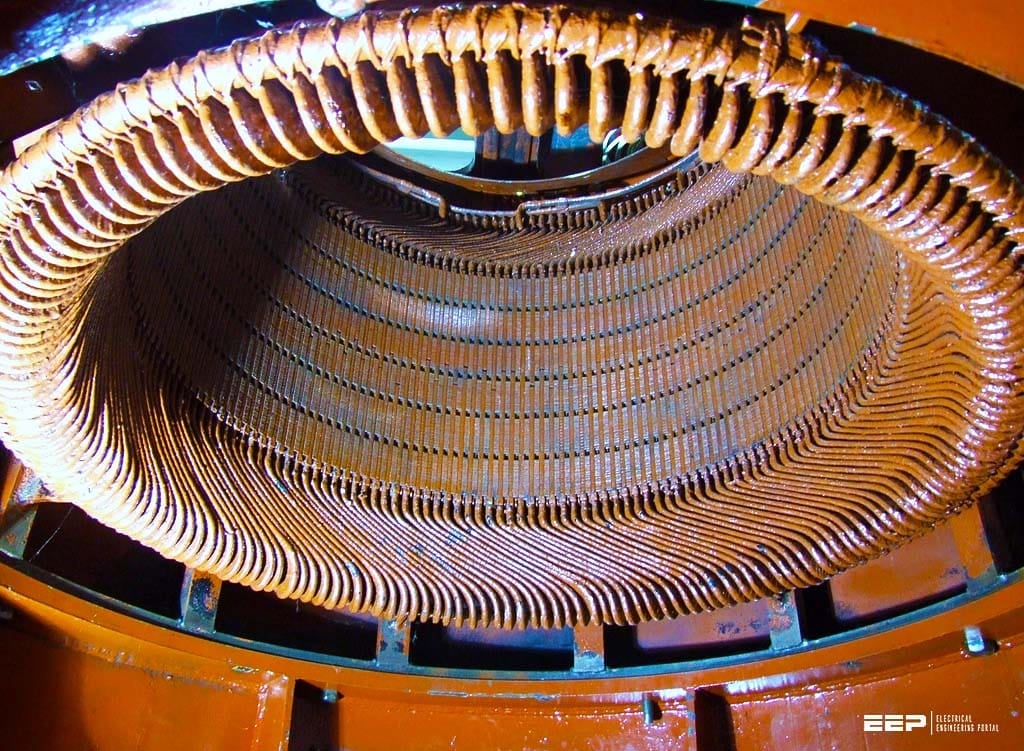Construction of a synchronous generator
In a synchronous generator, a DC current is applied to the rotor winding, which produces a rotor magnetic field. The rotor of the generator is then turned by a prime mover, producing a rotating magnetic field within the machine. This rotating magnetic field induces a three-phase set of voltages within the stator windings of the generator.

Two terms commonly used to describe the windings on a machine are field windings and armature windings. In general, the term “field windings” applies to the windings that produce the main magnetic field in a machine, and the term “armature windings” applies to the windings where the main voltage is induced.
For synchronous machines, the field windings are on the rotor, so the terms “rotor windings” and “field windings” are used interchangeably. Similarly, the terms “stator windings” and “armature windings” are used interchangeably.
On the other hand, a nonsalient pole is a magnetic pole constructed flush with the surface of the rotor.

A nonsalient-pole rotor is shown in Figure 1, while a salient-pole rotor is shown in Figure 2. Nonsalient-pole rotors are normally used for two- and four-pole rotors, while salient-pole rotors are normally used for rotors with four or more poles.
Because the rotor is subjected to changing magnetic fields, it is constructed of thin laminations to reduce eddy current losses.

A DC current must be supplied to the field circuit on the rotor. Since the rotor is rotating, a special arrangement is required to get the DC power to its field windings.
There are two common approaches to supplying this DC power:
- Supply the DC power from an external DC source to the rotor by means of slip rings and brushes.
- Supply the DC power from a special DC power source mounted directly on the shaft of the synchronous generator.
If the positive end of a DC voltage source is connected to one brush and the negative end is connected to the other, then the same DC voltage will be applied to the field winding at all times regardless of the angular position or speed of the rotor.
Slip rings and brushes create a few problems when they are used to supply DC power to the field windings of a synchronous machine. They increase the amount of maintenance required on the machine since the brushes must be checked for wear regularly.

In addition, the brush voltage drop can be the cause of significant power losses on machines with larger field currents. Despite these problems, slip rings and brushes are used on all smaller synchronous machines because no other method of supplying the DC field current is cost-effective.
On larger generators and motors, brushless exciters are used to supply the DC field current to the machine. A brushless exciter is a small AC generator with its field circuit mounted on the stator and its armature circuit mounted on the rotor shaft. The three-phase output of the exciter generator is rectified to direct current by a three-phase rectifier circuit also mounted on the shaft of the generator and is then fed into the main DC field circuit.

By controlling the small DC field current of the exciter generator (located on the stator), it is possible to adjust the field current on the main machine without slip rings and brushes. This arrangement is shown schematically in Figure 3, and a synchronous machine rotor with a brushless exciter mounted on the same shaft is shown in Figure 4 above.
Since no mechanical contacts ever occur between the rotor and the stator, a brushless exciter requires much less maintenance than slip rings and brushes.
To make the excitation of a generator completely independent of any external power sources, a small pilot exciter is often included in the system. A pilot exciter is a small AC generator with permanent magnets mounted on the rotor shaft and a three-phase winding on the stator. It produces the power for the field circuit of the exciter, which in turn controls the field circuit of the main machine.
| Title: | Synchronous machines (generator and motor) in a nutshell by Stephen J. Chapman |
| Format: | |
| Size: | 11.7 MB |
| Pages: | 113 |
| Download: | Here 🔗 (Get Premium Membership) | Video Courses | Download Updates |



This is high level technical knowledge of
electrical engineering given out to the general public for free.
I’m in great love with your school of thought.
Je suis très enchanté d’avoir la chance de lire tout sa c’est très enrichissant.
Je vous souhaite pour ingéniosité aux services de l’humanité.
Cordialement